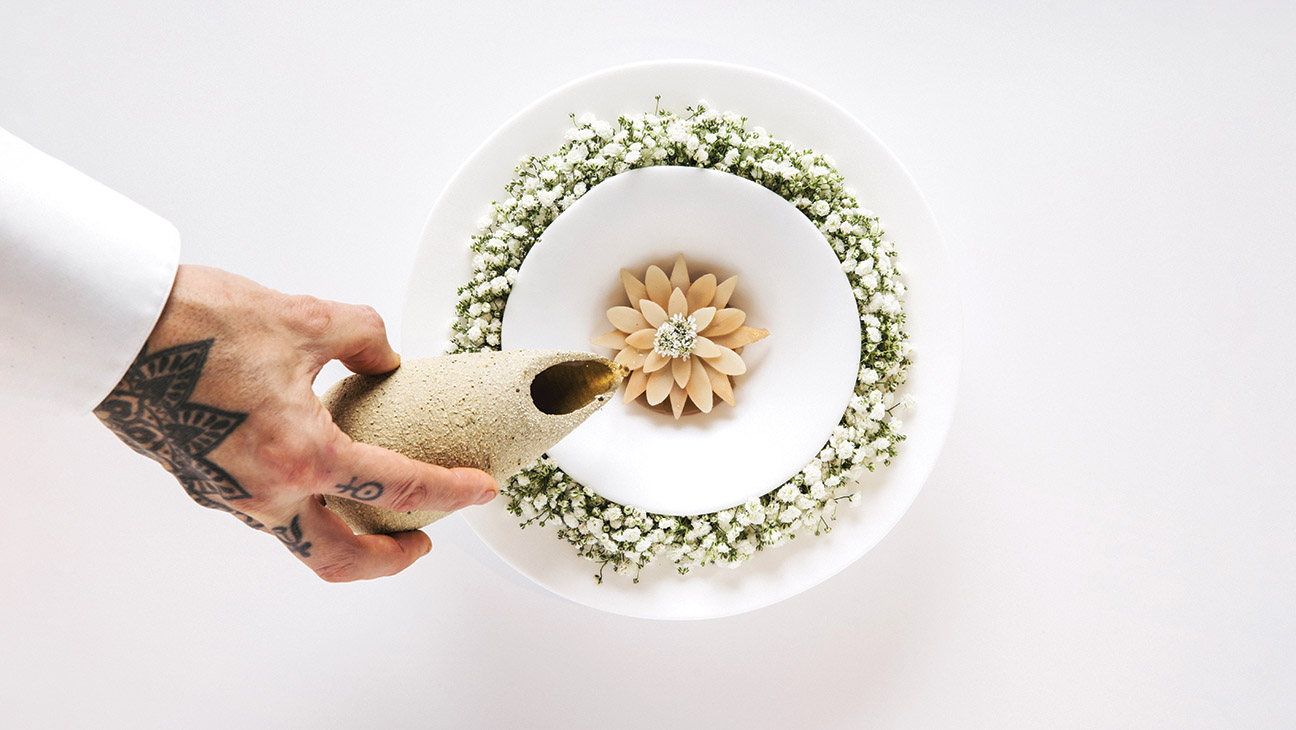

The few restaurants operating at the most ambitious end of L.A.’s fine dining scene are akin to white truffles: prized, delicate, thriving under only specific conditions.
Last year, the city lost both Curtis Stone’s Maude in Beverly Hills as well as Walter Manzke’s eponymous nearby haute cuisine citadel. Luckily, Seline and Somni — a rare pair of new specialists in elaborate tasting menus — have arrived, each showcasing its own adaptation to local terroir as it evolves amid shifts in client demographics and increasing economic pressures.
Related Stories
Seline, ensconced along lower Santa Monica’s Main Street in a space once occupied by Arnold Schwarzenegger’s Schatzi, is a moody room featuring large-scale paintings by controversial artist and Beef actor David Choe. Its chef-owner, Dave Beran, who held top roles at Chicago’s laureled Alinea and Next before earning a Michelin star for the short-lived Dialogue in Santa Monica, has gained traction in recent years with Pasjoli, a nearby Escoffier-riffing French bistro where Jeremy Allen White notably trained to play Carmy in The Bear. Here, Beran is turning out malted bananas, deconstructed squab and freeze-dried chestnut ice cream.

Somni, tucked behind Dan Tana’s and the Troubadour on Nemo Street in West Hollywood, is the airy, larger reincarnation of chef-owner Aitor Zabala’s original not far away, previously operating under the aegis of his mentor José Andrés. Now on his own, he’s overseeing a team that serves 20-plus courses — parmesan “feathers,” shiso tartare tempura, an oxtail bun — each evening across 14 counter seats in balletic unison.

Michigan-raised Beran and Barcelona-bred Zabala are auteurs with singular visions. A distinct Midwestern directness imbues Seline’s offerings, even as they’re run through the prism of Southern California’s farmers, foragers and other suppliers. Meanwhile, Somni specializes in invariably camera-ready, relentlessly playful expressions of Spain’s molecular gastronomy movement.
There’s notable overlap between the two. They’re each swapping out dishes on a constant basis, driven by the seasons. They’re besotted with their bespoke tableware. They’ve foresworn tablecloths. They’ve placed tremendous emphasis and attention on sui generis nonalcoholic pairings that in some cases may even upstage the wine.

Also, their service styles generally adhere to the poker-faced strictures of haute cuisine while at times subverting them: an otherwise all-business manager will joke about Erewhon between courses, or an erudite sommelier will refer, tongue partially in cheek, to the “bevvies” he’s pouring. This approach is apropos in casual-is-king L.A., where patrons are signing their steep bills in their sneakers and ballcaps. “People don’t mind spending the money — but they don’t want the formality of spending the money,” explains Beran. (Seline costs $295 a person, while Somni is $495; neither includes beverages, taxes or gratuities.)

The chefs are responding to the same cultural crosscurrents. Previous generations viewed fine dining as, in key part, knowledge acquisition. “Information was itself rare, a treasure,” Zabala says. “Now it’s always available, everywhere and anywhere. People arrive today wanting something else: The experience of participating in a special moment — and [with their phones] marking for others that they were part of it.”
These restaurants are facing heightened labor and ingredient costs. “These days, our cooks run the food to the guests,” observes Beran. “That’s a big change.” Inflation’s effect on food prices means that there’s less flexibility to feed inventive experimentation. Zabala puts it in terms familiar to any entertainment industry development executive: “Creativity is costly.”

Both chefs see the upside in L.A.’s minimal fine dining past. Tradition, of course, can be a straitjacket. Since there’s little shadow of influence, Beran says, “the city can be very open to your ideas.” Agrees Zabala: “L.A. gives you the opportunity to break rules because there are no rules. That’s perfect if you’re about doing your own thing and making your own history.”

This story appeared in the March 6 issue of The Hollywood Reporter magazine. Click here to subscribe.
THR Newsletters
Sign up for THR news straight to your inbox every day






